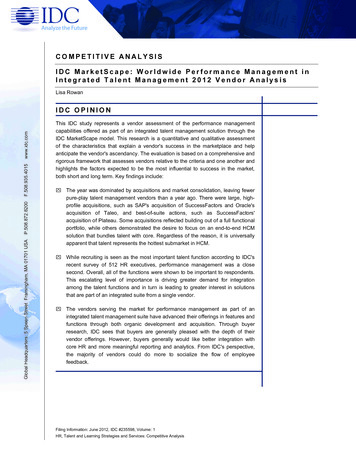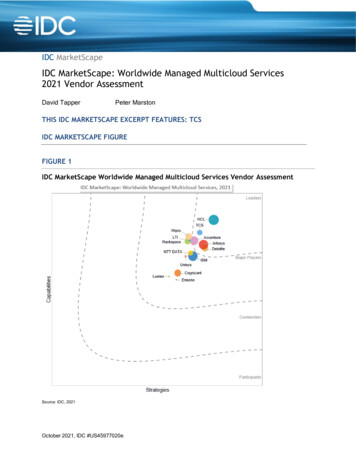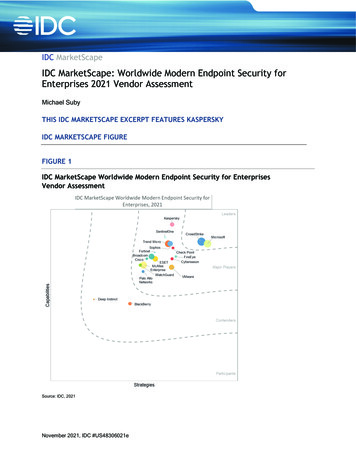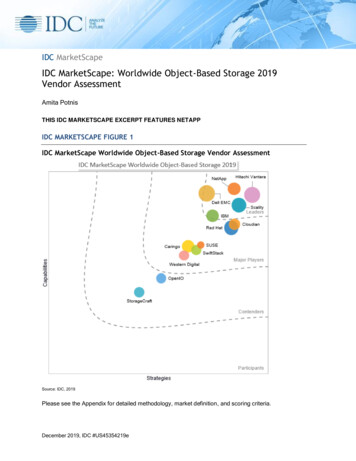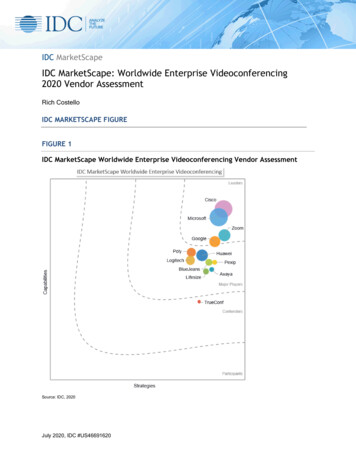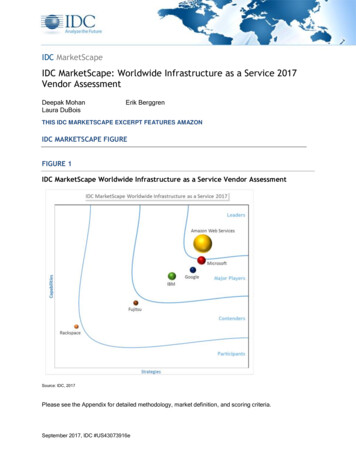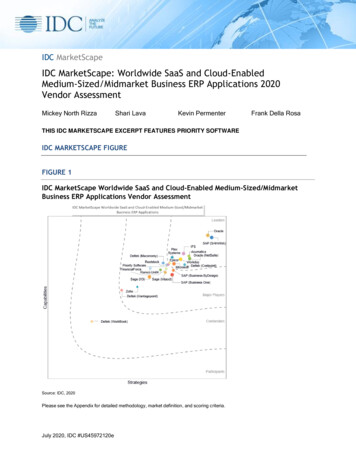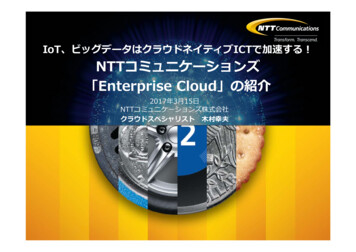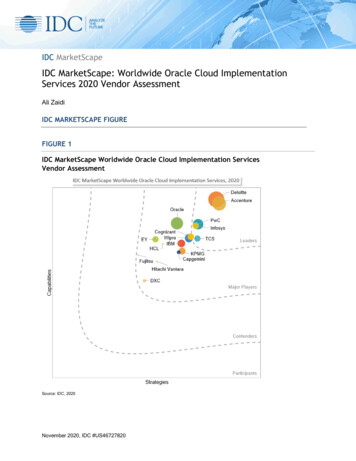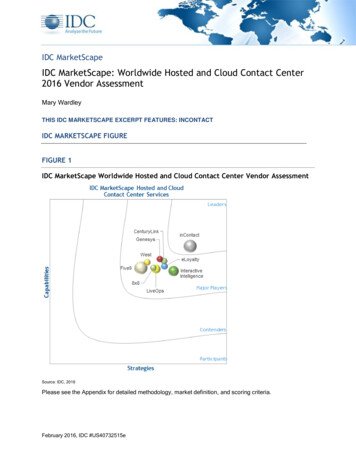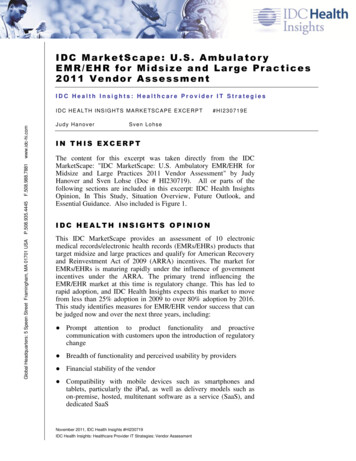
Transcription
IDC MarketScape: U.S. AmbulatoryEMR/EHR for Midsize and Large Practices2011 Vendor AssessmentIDC Health Insights: Healthcare Provider IT StrategiesGlobal Headquarters: 5 Speen Street Framingham, MA 01701 USAP.508.935.4445F.508.988.7881www.idc-hi.comI D C H E A L TH I N S I G H TS MA R K E T S C A P E E X C E R P TJ u d y H a n o ve r#HI230719ES ve n L o h s eIN THIS EXCERPTThe content for this excerpt was taken directly from the IDCMarketScape: "IDC MarketScape: U.S. Ambulatory EMR/EHR forMidsize and Large Practices 2011 Vendor Assessment" by JudyHanover and Sven Lohse (Doc # HI230719). All or parts of thefollowing sections are included in this excerpt: IDC Health InsightsOpinion, In This Study, Situation Overview, Future Outlook, andEssential Guidance. Also included is Figure 1.IDC HEALTH INSIGHTS OPINIONThis IDC MarketScape provides an assessment of 10 electronicmedical records/electronic health records (EMRs/EHRs) products thattarget midsize and large practices and qualify for American Recoveryand Reinvestment Act of 2009 (ARRA) incentives. The market forEMRs/EHRs is maturing rapidly under the influence of governmentincentives under the ARRA. The primary trend influencing theEMR/EHR market at this time is regulatory change. This has led torapid adoption, and IDC Health Insights expects this market to movefrom less than 25% adoption in 2009 to over 80% adoption by 2016.This study identifies measures for EMR/EHR vendor success that canbe judged now and over the next three years, including: Prompt attention to product functionality and proactivecommunication with customers upon the introduction of regulatorychange Breadth of functionality and perceived usability by providers Financial stability of the vendor Compatibility with mobile devices such as smartphones andtablets, particularly the iPad, as well as delivery models such ason-premise, hosted, multitenant software as a service (SaaS), anddedicated SaaSNovember 2011, IDC Health Insights #HI230719IDC Health Insights: Healthcare Provider IT Strategies: Vendor Assessment
IN THIS STUDYThis IDC MarketScape provides an evaluation of the market forEMRs/EHRs targeted at midsize and large ambulatory practices.Midsize and large ambulatory practices include those with 20 providersor more, and the vendors covered in this report represent those with asignificant presence in this market. This report is not all inclusive, andmany vendors that are not included in this report supply EMRs/EHRs tolarge practices. Eight vendors are covered in this report, while theEMR/EHR vendor space includes more than 150 vendors. The eightvendors in this report were selected on the basis of estimated marketshare, and all of the vendors in this report serve at least 15,000providers. Additional ambulatory EMR/EHR vendors will be covered inIDC MarketScape: U.S. Ambulatory EMR/EHR for Small Practices2011 Vendor Assessment (forthcoming), which covers emergingvendors with compelling technology serving smaller practices.MethodologyIDC MarketScape criteria selection, weightings, and vendor scoresrepresent well-researched IDC judgment about the market and specificvendors. IDC analysts tailor the range of standard characteristics bywhich vendors are measured through structured discussions, surveys,and interviews with market leaders, participants, and end users. Marketweightings are based on user interviews, buyer surveys, and the inputof a review board of IDC experts in each market. IDC analysts baseindividual vendor scores, and ultimately vendor positions in the IDCMarketScape, on detailed surveys and interviews with the vendors,publicly available information, and end-user experiences in an effort toprovide an accurate and consistent assessment of each vendor'scharacteristics, behavior, and capability.The sources of information for this report include: Vendor briefings. Vendors whose products are featured in thisreport provided briefings, with the exception of McKesson, EpicSystems, and NextGen Healthcare, which were offered theopportunity to provide briefings but declined. Customer references. Interviews were held with customers of theproducts covered in the report, including those references providedby the vendors as well as other customer references known to IDCHealth Insights. At least two detailed half-hour referenceconversations were held for each product covered. Secondary research. Secondary research for the report includedvendor, user, and product Web sites and blogs as well as existingPage 2#HI230719 2011 IDC Health Insights
IDC Health Insights research covering this market and theseproducts.The definitions of EMR and EHR can be complicated and confusing.This report uses the term EMR/EHR to refer to those EMR and EHRproducts that meet, or are expected to meet, the federal qualificationsfor certification for meaningful use.SITUATION OVERVIEWIntroductionEMR/EHR Market Drivers: ARRA and Healthcare ReformIn May 2011, office-based providers that had implemented anddemonstrated Phase 1 of meaningful use under the law began receivingincentive payments, providing compelling motivation for providers tomove forward on EMR/EHR implementations. Eligible providers(EPs) that implement a certified EMR/EHR before 2012 will receivethe maximum incentive payments over the full five years, and forproviders of Medicare services, this is up to 44,000, while Medicaidproviders can qualify for up to 63,750 in incentives. This incentive,paid per provider, provides a significant opportunity for providers tohelp defray the costs associated with acquiring, implementing, andadopting an EMR/EHR. This is particularly true for midsize and largepractices where economies of scale increase the impact of theincentives. Key IDC Health Insights findings include: The use of EMRs/EHRs in ambulatory practices with more than 20providers can result in benefits, including a paperless environment,ubiquitous availability of clinical information, e-prescribing,electronic ordering and receipt of radiology and laboratory results,charge capture, and improvements to patient safety and the qualityof care as a result of features such as clinical decision support. Large practices also see economies of scale that accrue withprocess efficiencies upon EMR/EHR introduction as improvementsto charge capture, documentation, and billing practices enhancerevenue for the practice, driving return on investment. However,selecting the right EMR/EHR and choosing functionality thatmeets the needs of the many providers in the practice withoutcreating unnecessary complexity or support costs are critical. 2011 IDC Health Insights#HI230719Page 3
FUTURE OUTLOOKIDC MarketScape Ambulatory EMR/EHR forMidsize and Large Practices Market VendorAssessmentThe IDC vendor assessment for the ambulatory EMR/EHR for midsizeand large practices market represents IDC's opinion on which vendorsare well positioned today through current capabilities and which arebest positioned to gain market share over the next few years.Positioning in the upper right of the grid indicates that vendors arewell positioned to gain market share. For the purposes of discussion,IDC divided potential key strategy measures for success into twoprimary categories: capabilities and strategies.Each product has been evaluated against 48 criteria and dividedbetween the two main categories: current capabilities and strategycapabilities. Within each of these criteria, we have weighted specificfeatures of the product or the product's vendor that are particularlysignificant for purchasers of the software and for users.Positioning on the y-axis reflects the vendor's current capabilities andmenu of services and how well aligned the vendor is to customerneeds. The capabilities category focuses on the capabilities of thecompany and product today, here and now. Under this category, IDCanalysts look at how well a vendor is building/delivering capabilitiesthat enable it to execute its chosen strategy in the market. Thecapabilities scoring model weights the functionality, delivery model,customer service, and the financial condition or funding model of thevendor as the most important.Positioning on the x-axis or strategies axis indicates how well thevendor's future strategy aligns with what customers will require in oneto four years. The strategies category focuses on high-level strategicdecisions and underlying assumptions about offerings, customersegments, business, and go-to-market plans for the future, in this casedefined as the next one to four years. Under this category, analysts lookat whether or not a supplier's strategies in various areas are aligned withcustomer requirements (and spending) over a defined future time period.The strategies scoring model weights the functionality, pricing, salesand distribution model, and the financial condition or funding modelof the vendor as the most important.Figure 1 shows each vendor's position in the vendor assessment chart.Its market share is indicated by the size of the bubble and a ( ), (-), or() icon indicates whether or not the vendor is growing faster than,slower than, or even with, respectively, overall market growth.Page 4#HI230719 2011 IDC Health Insights
FIGURE 1IDC MarketScape: U.S. Ambulatory EMR/EHR for Midsize andLarge Practices Market Vendor AssessmentSource: IDC Health Insights, 2011Vendor Summary AnalysisWith respect to both current capabilities and strategy capabilities,eClinicalWorks, Cerner, Sage, and NextGen stand out among the"Major Players." Each offers competitive products that align withcustomer perceptions of value and strong functionality, and they haveexecuted sound business strategies that are very likely to align withcustomer needs as the market evolves. However, each productdemonstrates its own strengths. These strengths are highlighted in theprofiles discussed in the sections that follow.eClinicalWorks: eClinicalWorkseClinicalWorks (www.eclinicalworks.com) is a privately heldcompany founded in 1999 and headquartered in Westborough, 2011 IDC Health Insights#HI230719Page 5
Massachusetts. It reports 2010 revenue of more than 150 million.eClinicalWorks is focused entirely on the ambulatory EMR/EHR andpractice management space, and its product suite is marketed under thecompany name. eClinicalWorks is focused on providing low-cost,intuitive functionality to outpatient ambulatory practices of all sizes.The company has strong penetration among small, midsize, and largepractice groups and networks of practices and claims 50,000physicians in 8,000 practices use its products. The product suiteincludes an EMR/EHR and integrated practice managementapplication.eClinicalWorks stands out as a Major Player with respect to bothcriteria for current capabilities and strategies. A key to its competitiveposition lies in eClincalWorks' early commitment to, and competentexecution of, the SaaS delivery model. In recent years SaaS hasdemonstrated that it is technologically reliable and secure enough tosatisfy the requirements of current users in the mid-large ambulatorymarket. Thus users can now confidently expect to realize thesignificant reductions in initial investment, on-going cost, and overallprice competitiveness that SaaS offers. Acceptance of SaaS in theprovider marketplace has improved and SaaS has become acompetitive differentiator for all ambulatory EMR/EHR vendors. Weexpect that SaaS will become even more important as a competitiveadvantage for eClinicalWorks in the future due to the demands for lowcost infrastructure solutions.The eClinicalWorks suite of EHR and PM software is typicallydeployed together and is available on most deployment platforms andpayment models. The eClinicalWorks EMR/EHR is Internet based andcan be either installed at customer sites or accessed as SaaS, suppliedas an ASP by eClinicalWorks. About 90% of sales are direct, andeClinicalWorks provides its own implementation services using an inhouse team and a templated 12-week implementation process for EMRand PM, eight weeks for just EMR.Specific functionality for specific practice sizes, specialties, and usage(e.g., Patient Portal and eClinicalMobile) can be easily enabled withinthe basic software suite. eClinicalWorks integrates with numerousthird-party hospital systems via XML, IHE, or HL7 data transfer.eClinicalWorks is enabled for use on wireless devices and optimizedfor use with tablet PCs. Reporting is ad hoc via Crystal Reports orCognos and is individualized for the needs of the large provider groupsthat make up the majority of the company's customer base.eClinicalWorks reporting is used for participation in pay-forperformance programs by a number of its clients and has met therequirements for reporting by federally qualified health centers.eClinicalWorks has experienced rapid growth since 2004 and claims tohave grown 44% from 2009 to 2010. The range of practice sizesamong its client base spans from 1 to 1,700 providers. High-profilePage 6#HI230719 2011 IDC Health Insights
customers include Memorial Hermann, Children's Hospital Boston,Beth Israel Deaconess Medical Center, and many federally qualifiedhealth centers, as well as the New York City Department of Health andMental Hygiene. eClinicalWorks is CCHIT ONC-ATCB certified for2011–2012 with an additional certification for Child Health in 2008and for 2011–2012.ESSENTIAL GUIDANCETo meet all of the challenges of EMR adoption and get to meaningfuluse while preparing for healthcare reform, it is clear that ambulatoryproviders need integrated EMR/EHR solutions that address not onlythe total cost of ownership for the technology but also theinfrastructure, workflow, and human factor issues associated with thenew technologies.Healthcare reform in the provider space signifies a convergence ofinitiatives that will drive disruptive change in the provider industry.Ambulatory providers are initially faced with implementing anddemonstrating meaningful use of EMR/EHR systems to secureincentive payments under ARRA; these systems provide enablingtechnology for a series of changes to operating models, informationsystems, and workflows that will facilitate providers' movementtoward healthcare reform. In the emerging health reform ecosystemunder PPACA, providers are faced with the need to provide higherquality care, at lower cost, to more patients than ever before. To allowproviders to accomplish this and participate successfully in healthcarereform, tools will be needed that facilitate change at the point of care,help providers understand and respond to changes in their operatingenvironment, profitably participate in new business models, andcomply with new regulatory initiatives.Actions to ConsiderKey Considerations for EMR/EHR SelectionAddressing as many issues as possible in the EMR/EHR solution willhelp accelerate adoption for providers and drive users toward bothmeaningful use and the quality and efficiency goals associated withhealthcare reform. An EMR/EHR solution for an ambulatory practiceshould address: EMR/EHR application selection and licensing. EMR/EHRapplication choices include decisions about architecture anddelivery. Practices should carefully consider whether they plan toinvest in onsite servers and support, or if offsite hosting andsoftware-as-a-service offerings are more practical given theiravailable resources for support, facilities, and budget. Licensingoptions include subscription and perpetual licenses for installed or 2011 IDC Health Insights#HI230719Page 7
hosted software, as well as lease agreements for SaaS options.Decisions on delivery and licensing affect the implementationprocess, the cost of the application, and the eventual experience ofthe practice in the day-to-day use of the application. Thearchitecture of the application and how suitable this architecture isto delivery via hosting and/or SaaS are strong determinants of thefunctionality and performance available from the application, aswell as the cost, and should be considered during the selectionprocess. Funding models and ARRA incentive availability. While Phase1 stimulus incentives became available in 2011, Phase 2 incentiveswill not be available until 2013, increasing the time lag betweenthe EMR/EHR investment and a significant portion of theincentive payments. SaaS applications can help address this lag bylowering up-front costs, although practices should also look intofinancing that may be available from vendors and/or local hospitalsto bridge the gap until the bulk of stimulus funds arrive. Availability of functionality for ARRA and healthcare reform.Demonstrating meaningful use requires the collection andaggregation of multiple data elements, specific reporting toolswithin the EMR/EHR, capabilities that may require patient-facingtools or portals, and health information exchange (HIE). While thePhase 1 meaningful use requirements have been finalized and all ofthe vendors covered in this IDC MarketScape have delivered therequired functionality and are certified for meaningful use, theirperformance in this area has varied. With Phase 2 and 3meaningful use requirements pending, and additional requirementsexpected to support the ICD-10 conversion deadline of October 1,2013, as well as future requirements that will be determined tosupport accountable delivery and healthcare reform, vendorperformance on delivering Phase 1 meaningful use functionalityshould be examined as a predictor of future performance meetingthese regulatory change requirements. Providers makingEMR/EHR selection decisions should consider a vendor's trackrecord on the availability of meaningful use releases for Phase 1;the vendor's road map for ICD-10 and Phase 2 upgrades; thebacklog/availability of implementation resources for implementingnew releases once they are made available; the code quality andsupport issues customers may have experienced whenimplementing the Phase 1 releases; and the cost of upgrading,implementing, and/or purchasing additional product modules, suchas a patient portal, or accessing functionality required formeaningful use. Additionally, the compatibility and ease ofintegration of the product with systems used by local, collaboratingambulatory providers, hospitals, and HIEs should be consideredwhen selecting a system to avoid the future disruption and costassociated with replacing incompatible EMR/EHR products.Page 8#HI230719 2011 IDC Health Insights
User interface. EMR/EHR decisions for ambulatory practicesshould take user interface style into consideration. Unlike many ofthe other applications used in the ambulatory setting, such aspractice management and billing applications, EMRs/EHRs areused by the providers themselves and not office staff. As they usethe EMR/EHR to document clinical encounters, the applicationwill be used for long periods of time, every day. Most EMR/EHRapplications use a template-based user interface, althoughvariations and dynamic applications of templates can affect theworkflow of the application and the user experience, and in somecases, one user interface may be a better fit for a particular practicethan another. For many large practices, customization at theenterprise level may be desirable for many templates and dataelements, but customization capabilities for the layout andworkflow at the group or individual provider level may be helpful,particularly for multispecialty practices. Providers need to beintimately involved in the selection process to ensure that the styleof the application fits their needs and, in large practices, those oftheir peers. Clinical staff buy-in. Physician and nurse buy-in and theirparticipation in both the system selection and implementation andthe determination of configuration options are critical for asuccessful EMR/EHR implementation. In situations whereproviders resist efforts to place orders and/or document clinicalnotes electronically, the EMR/EHR is less efficient and benefits donot accrue as significantly to the practice. The persistence of papercomponents of medical records or the wide-scale incorporation ofscanned document content reduces the overall efficiency of theEMR/EHR. Physician and nurse participation in system selectioncan help identify electronic documentation and ordering solutionsthat have simple and intuitive functionality that meets the needs ofthe practice. Participation can also help clinical staff betterunderstand trade-offs that need to be made during the decisionprocess and lessen the likelihood of widespread resistance toadoption. Regardless of the actual functionality, leadership andacceptance of the EMR/EHR by providers with a stake in thefuture of the practice are critical. End-to-end technology site assessment. The technology aspectsof EMR/EHR adoption only begin with selecting and licensing asoftware solution. While the right software functionality can easethe workflow transition and burden of adoption on providers, theIT infrastructure at the practice also needs to be prepared for theEMR/EHR or a solution such as SaaS that lowers infrastructurerequirements. EMR/EHR response time, uptime, and availabilityare critical components of physician satisfaction, and attention andaccurate assessment of the server and infrastructure configurationcan help ensure satisfactory performance. In addition, ifEMR/EHR is to provide the required foundation for practices to 2011 IDC Health Insights#HI230719Page 9
participate in HIE, and accountable care programs under healthcarereform, these elements are critical. Readiness of the practice and providers. The success of anEMR/EHR implementation and the level of eventual use ofordering functionality, particularly by providers, are tied to thereadiness of the organization and approach to implementation.Readiness happens in degrees — while most practices will havethe goal of getting to meaningful use by the deadlines to ensuremaximum stimulus payments, additional steps may be required forsome teams to prepare and implement according to these timelines.Customizing the solution and implementation approach to thepractice, specialty, and team are key variables that lead toacceptance and use of systems. Process improvement and clinical transformation. The abilityof an organization to meet the goals and objectives of anEMR/EHR project is closely tied to the practice's underlyingability and readiness to transform its administrative and clinicalprocesses. Appropriate change management processes, includingstrong leadership and team-based approaches, must be in place toassist in this process. In many cases, EMR/EHR implementationsthat fail, don't hit adoption targets like meaningful use, or facestrong resistance from staff failed to provide the underlyingsupport in the form of training, preparedness, and support duringthe initial stages of implementation. The practice's processes andworkflow need to be assessed, and the nature and scope of changesto the workflow as well as the ability of the selected EMR/EHRapplication to support the desired workflow need to be determined.This clinical transformation process should be continuous and canbe leveraged going forward to support the changes in businessmodels that will be required for accountable care and healthcarereform. Integration with practice management systems. Existingpractice management systems represent investments that can beleveraged during EMR/EHR implementation. However, expectedchanges in provider needs for revenue cycle managementcapabilities under healthcare reform, the upcoming implementationof the Version 5010 standard for HIPAA transactions and ICD-10coding, and the introduction of high deductible plans and pay-forperformance programs by payers may make a practicemanagement system change timely. Practice managementapplications increasingly require more integration across revenuecycle and clinical data in a practice. In many cases, an EMR/EHRimplementation will go hand in hand with the replacement ofoutdated practice management products. This can extend and addcomplexity to the implementation. However, many practices reportsignificant financial benefits from the integration of charge captureand E&M coding documentation with clinical documentation usingPage 10#HI230719 2011 IDC Health Insights
an EMR/EHR. The integration with clinical documentation allowsfor more accurate coding with built-in documentation ofcomplexity levels, removing the need to code conservatively andimproving reimbursement, and this benefit will continue to beimportant with ICD-10 implementation. While many practicemanagement vendors also offer integrated EMRs/EHRs, others donot; for some practices, the EMR/EHR offered by the practicemanagement vendor may not be the system of choice, or thepractice management system offered by the EMR/EHR vendor ofchoice is not appropriate to the practice. The practice needs toconsider the trade-offs associated with not using an integratedpractice management and EMR/EHR system and make a decisionthat meets the needs of the individual practice. Interoperability. Interoperability is a requirement of meaningfuluse and healthcare reform, and providers will need to implementinteroperable systems that participate in health informationexchange and actively exchange data with local hospitals, payers,and other providers to qualify for reimbursement under ARRA andparticipate in future accountable delivery networks. Ambulatoryproviders should consider options available in collaboration withlocal hospitals and HIEs that extend CPOE capabilities to localhospital laboratory and radiology facilities. InteroperableEMRs/EHRs also create additional efficiencies for providers asthey are able to see and exchange data with their fellow careproviders, collect data from across the continuum of care for careand disease management activities, and improve the quality of careand lower costs by reducing the number of duplicate tests andprocedure that are performed because data on past care is notavailable. These efficiencies are a critical component of successfulaccountable care and systems that facilitate them are a keyinvestment for ambulatory practices that want to profit under apatient-centered medical home or accountable delivery model. Budget. The cost of acquiring, implementing, and maintaining anEMR/EHR application is a hurdle for many practices despite thecost relief provided by ARRA. Pricing of ambulatory EMR/EHRsystems varies widely and is not always proportional to theproduct's functionality and value. Practices of all sizes shouldconsider vendors that offer Web-based applications and SaaSoptions for delivery, integrated practice management, and vendorsthat specialize in the small practice space for simple, easy-to-useapplications that meet their needs. Large and multispecialtypractices should consider vendors that allow them to integratesophisticated practice management functions and achieve theiroperational goals while meeting the clinical documentation needsof all of their providers. All of the costs that will be incurred needto be considered in addition to license fees. An application that iseasy to use can lower the opportunity costs of implementation bygetting staff to start using the application sooner and reducing 2011 IDC Health Insights#HI230719Page 11
downtime for the practice (usually operating at a reduced schedule)during implementation. IT support availability. Support cost and complexity should becarefully weighed. Service-oriented architecture can save onintegration costs, and service-based delivery models such ashosting and SaaS can be used to lower up-front acquisition costsand ongoing support charges. Providers need to understand theimplications of housing an EMR/EHR server onsite, such as thephysical environment, backup, and disaster recovery options, whenmaking the decision to install a mission-critical EMR/EHRapplication onsite. Unlike practice management systems,EMRs/EHRs require high availability and have stringent uptimerequirements for access to clinical data while physicians are oncall, an increased support requirement that should be considered.EMR/EHR Application DifferentiatorsWith over 150 vendors currently offering ONC-certified technologyfor meaningful use, EMR/EHR vendors are seeking to differentiatethemselves however possible. The ARRA deadlines to completeimplementations and qualify for incentives have created a battle forEMR/EHR market share. EMR/EHR differentiation strategies vary,and differentiation on the basis of functionality is limited, asEMR/EHR functionality is largely specified by the meaningful userequirements and certification specifications instituted prior to 2009.In the absence of true differentiators based on functionality, keydifferentiators in the EHR market in 2011 include but are not limitedto user interface design/usability, the financial stability of the vendor,the future road map of the vendor, channels and channel strategies,service offerings, delivery models, application architecture andinfrastructure requirements, available pricing models, clinical mobilityoptions, integration strategies, and the availability of complementaryproducts/modules such as practice and revenue cycle managementapplications and services. With the vast number of EHR vendorscompeting for meaningful use installations, many serve a smallcustomer base, and the growing functionality requirements formeaningful use make the financial stability of the vendor, and itsability to invest in the research and development required to supportand sustain meaningful use certification, of vital importance toproviders selecting applications.It is clear that the EHR vendor landscape is consolidating, and manyvendors are struggling to gain market share, build economies of scale,and offer products and services at competitive prices to meet thedemands of meaningful use and survive in the post-ARRA market.Vendor differentiators in the EMR/EHR market that providers shouldconsider during EMR/EHR selection include:Page 12#HI230719 201
The eClinicalWorks EMR/EHR is Internet based and can be either installed at customer sites or accessed as SaaS, supplied as an ASP by eClinicalWorks. About 90% of sales are direct, and eClinicalWorks provides its own implementation services using an in- house team and a templated 12-week implementation process for EMR .
